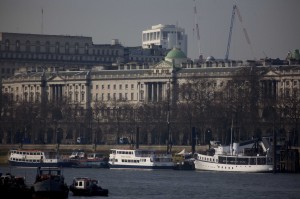An interview with air quality expert Timothy Baker
Air pollution is a hot topic in London. Mayor Sadiq Khan has raised the issue repeatedly over the last few months, promising an ultra low emission zone (ULEZ) in central London by 2019. King’s College London is contributing to the debate through the work done by the Environmental Research Group (ERG). The ERG is a leading provider of air quality research in the UK and shares information on air quality in London with the public, including “nowcasts” showing current pollution levels, and pollution forecasts. The Sustainability Team met up with Timothy Baker from the ERG’s Measurement team to talk about the work of the ERG and the dangers of and solutions to pollution. This blog post is the first of three in our series on air quality, and will focus on why air quality research in London matters.

If you have been following the King’s College London Twitter account recently, you will have noticed their Q&A on pollution with members of the ERG. It enabled anyone interested to pose their questions to the experts, and encouraged an open discussion on pollution. Our expert Tim Baker explains why bringing attention to air pollution is important:
“Unfortunately it is one of those stories that will only get worse and worse. As more and more research goes on, we realise it affects us in so many more ways than what was originally thought.”
According to Tim, latest research shows that the health impacts of pollution can go far beyond the respiratory system. For example, particles could enter the bloodstream and cause cardiovascular problems. Children are one of the groups most at risk, especially since they may be exposed to high pollution levels on their way to school. The consequences of this are often long-term. Tim Baker explains that researchers looked at how pollution affects schoolchildren’s lung functions in Hackney and Tower Hamlets.
“They got some strong results that living in an area that has elevated pollution results in stunted lung growth in children. And one of the issues with that is that you never get it back.”
Knowing one’s exposure to pollution can be equally as important as knowing which particles are in the air. This can include the location itself, as well as how long is spent at a location. While many people might be reluctant to walk or cycle along a busy road due to pollution levels, Tim Baker claims that the most polluted place on a road is often inside cars: “The car is the most polluted place to be. Even though people think ‘Oh, I don’t want to walk along that road because it’s polluted’, if you’re in a car, you’re going to be more exposed than when you’re walking or cycling.” One of the reasons for this is that if a car is stuck in traffic, as is often the case in London, passengers might be exposed to emissions from surrounding vehicles.
An area that has seen little research so far is the London Underground network. Even though up to 4.8 million passengers travel on the Tube every day, air quality measurements have been very limited until recently, and therefore it is hard to make a statement on what impact pollution on the Underground has on commuters and TfL staff members. Most measuring equipment is both expensive and bulky, making it difficult to measure air quality on the go, for example during a commute. New smaller, and more affordable, sensors are increasingly available on the market, but their measurements might not be accurate, nor give users a full picture of pollution levels. Nevertheless, they could be useful for giving indicative measurements of people’s everyday exposure to pollution. The ERG has given small sensors to office workers, ambulance drivers and schoolchildren to better understand daily exposure. Tim Baker says he is hopeful that these small, cheaper sensors will be improved in the future, as this would mean more sensors could be placed all over the city and give a better picture of air quality.
 For the time being, air quality measurements for London can be viewed on the LondonAir website, and the team regularly releases updates on pollution levels on Twitter. The next part of our series on air pollution will focus on what causes pollution in London, who some of the worst polluters are, and what should be done to tackle this – make sure not to miss it by following us on Twitter and Facebook!
For the time being, air quality measurements for London can be viewed on the LondonAir website, and the team regularly releases updates on pollution levels on Twitter. The next part of our series on air pollution will focus on what causes pollution in London, who some of the worst polluters are, and what should be done to tackle this – make sure not to miss it by following us on Twitter and Facebook!

